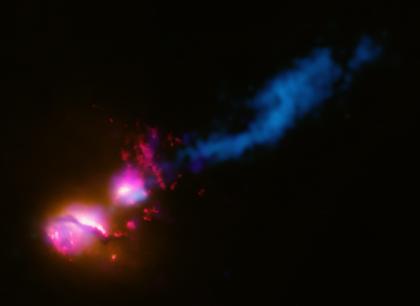I've Never Seen Star Wars But...
Dr. Dan Evans from the Harvard-Smithsonian Center for Astrophysics in Cambridge, MA, shares some information on 3c321, as of December 2007 now known as the Death Star Galaxy. Dan Evans has never seen Star Wars, so who came up with the nickname? Read on.
-----------------
NASA's Chandra X-ray Observatory has opened up a new era of performing x-ray astronomy and x-ray astrophysics.
I'd like to show you a specific example of something that my colleagues and I have been working on recently. This is a black hole firing at the neighboring galaxy. A powerful jet of particles is being ejected from the super massive black hole in the center of a distant galaxy. And an unfortunate neighboring galaxy has moved directly into its line of fire. We'll see that this doesn't only cause the jet to disrupt and to bend and to flare, but it may actually have very disastrous consequences for any earthlike planets flying in its path.

3C321 (X-ray: NASA/CXC/CfA/D.Evans et al.; Optical/UV: NASA/STScI; Radio: NSF/VLA/CfA/D.Evans et al., STFC/JBO/MERLIN)
What you are seeing with this beautiful image is a multiwavelength observation of a so-called radio galaxy. This radio galaxy is known as 3C321. This galaxy lies at a distance of around 1.4 to 1.5 billion light years from us.
We know that nearly all galaxies have super massive black holes in their centers, but only relatively few consume large quantities of material. That causes the light from these so-called active galactic nuclei to outshine the sum of all the starlight in that whole galaxy.
Only around 10% of all galaxies have what we call actively accreting, actively eating super massive black holes. 10% of those - so 1% of the total galaxy population, eject what we call powerful colonated jet particles from the vicinity of their black holes.
These galaxies are known as radio galaxies. These jets transmit very strongly at radio wavelengths, and we think that jets have launched so close to the speed of the light from black holes and can travel vast distances, often to in excess of millions of light years.
This wonderful image that you see is a multiwavelength composite of 3C321. We can see emission from the radio wavelength in blue from optical taken with the Hubble Space Telescope in a sort of orange color. Ultraviolet is this sort of wonderful red color, and then observations from Chandra in the x-ray are shown in purple. Now I'd like to describe to you actually what's happening here.
You can see that a powerful jet of particles, which is shown in blue, is launched from the vicinity of the black hole in this main galaxy. That's the one at the lower left. You can see it's the bigger of the two. The jet actually races outwards close to the speed of light in initially very colonated pencil beam-like structure.
However, at a distance of only around 20,000 light years from the main galaxy is a smaller, neighboring galaxy. And unfortunately it's lying right in the path of the jet. What happens next is the jet violently slams into the lower half of that neighboring galaxy, after which the jet dramatically twists, bends and flares. This could have really disastrous consequences for any earthlike planets that lie in the path of the jet.
Side note: I would like to point out that Chandra [EPO] has been absolutely hammering trying to make me call it a death star galaxy. That's something Star Warsy, if you like. But I actually pointed out to them rather kindly that I wasn't born when that movie was released. So anyway, you might think that this so-called death star galaxy is unusual. In some sense it really is an astronomical setting. But there's actually a very simple, terrestrial analog, and that's mainly putting your hands into a fire hose.
-Dan Evans
